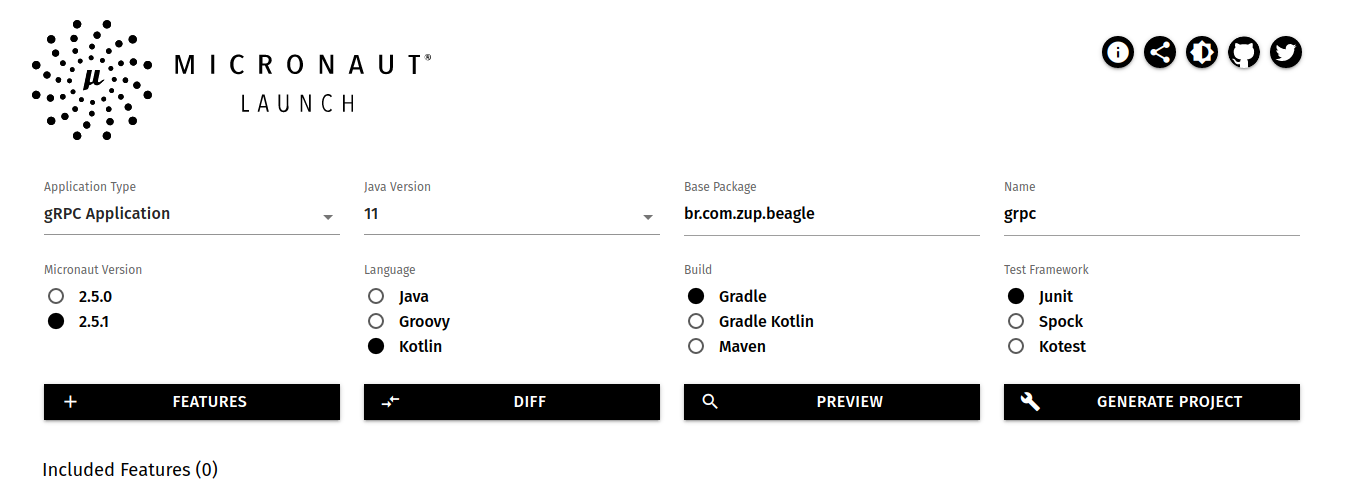Beagle gRPC
What is gRPC?
gRPC is a new and fast growing technology that allows different systems to communicate through a network connection. It’s based on HTTP 2 and is an alternative to the more common standard REST. The gRPC proposal is that the client interacts with the server through simple function calls. These functions are code automatically generated via the gRPC tool.
How Beagle gRPC works?
This library allows you to create Beagle BFFs serving screens through gRPC. It acts as a translator, converting Beagle JSONs to protocol buffer messages. The lib provides an abstraction that implements a gRPC service that makes it possible to register your screens, and a method that returns them to a gRPC client.
How to use Beagle gRPC in your BFF project
- Requirements:
- JDK 8+
- It is recommended that you use a lib with Spring Boot or Micronaut to help on usability. Follow both examples below.
Step 1: Create gRPC project
Using Spring Boot project generator
- You can access Spring Boot website here and generate a zip project with the basic settings already configured.

Using Micronaut project generator
- You can access Micronaut website here and generate a zip project with the basic settings already configured

- Open the extracted folder in your favorite IDE. We recommend Intellij Community.
Step 2: Install Beagle gRPC lib
- Open the gradle.build file (or pom.xml if you choose Maven) in your project root and add the Beagle gRPC library
Gradle project
dependencies {
...
implementation("br.com.zup:beagle-grpc-backend:${beagleGrpcVersion}")
implementation("net.devh:grpc-server-spring-boot-starter:${springGrpcVersion}")
}
Maven project
<dependencies>
...
<dependency>
<groupId>net.devh</groupId>
<artifactId>grpc-server-spring-boot-starter</artifactId>
<version>${spring.grpc.version}</verion>
</dependency>
<dependency>
<groupId>br.com.zup</groupId>
<artifactId>beagle-grpc-backend</artifactId>
<version>${beagle.grpc.version}</verion>
</dependency>
</dependencies>
Gradle project
dependencies {
...
implementation("br.com.zup:beagle-grpc-backend:${beagleGrpcVersion}")
}
Maven project
<dependencies>
<dependency>
<groupId>br.com.zup</groupId>
<artifactId>beagle-grpc-backend</artifactId>
<version>${beagle.grpc.version}</verion>
</dependency>
</dependencies>
Step 3: Create a Beagle Screen
Using Beagle screen builders
- Create a class named HomeScreen and extend it from ScreenBuilder, that is a Beagle framework class
import br.com.zup.beagle.widget.layout.Container
import br.com.zup.beagle.widget.layout.Screen
import br.com.zup.beagle.widget.layout.ScreenBuilder
import br.com.zup.beagle.widget.ui.Text
class HomeScreen(private val parameters: String) : ScreenBuilder {
override fun build() = Screen(
child = Container(
children = listOf(
Text("Hello. This is a $parameters!")
)
)
)
}
- Create another class named SplashScreen that extends from ScreenBuilder too.
import br.com.zup.beagle.core.Style
import br.com.zup.beagle.ext.applyStyle
import br.com.zup.beagle.widget.action.Navigate
import br.com.zup.beagle.widget.action.Route
import br.com.zup.beagle.widget.core.EdgeValue
import br.com.zup.beagle.widget.core.UnitValue
import br.com.zup.beagle.widget.layout.Screen
import br.com.zup.beagle.widget.layout.ScreenBuilder
import br.com.zup.beagle.widget.ui.Button
object SplashScreen : ScreenBuilder {
override fun build() = Screen(
child = Button(
text = "Button example",
onPress = listOf(
Navigate.PushView(
Route.Remote(
"text",
true
)
)
),
).applyStyle(
style = Style(
margin = EdgeValue(
top = UnitValue.real(15)
)
)
)
)
}
Step 4: Create a gRPC service
Using Beagle gRPC lib
- Create a class named MyBeagleAppService and extend it from BeagleScreenService
import br.com.zup.beagle.widget.layout.ScreenBuilder
import br.com.zup.grpcbff.interceptor.BeagleHeadersInterceptor
import br.com.zup.grpc.BeagleScreenService
import net.devh.boot.grpc.server.service.GrpcService
import br.com.zup.grpcbff.screen.HomeScreen
import br.com.zup.grpcbff.screen.SplashScreen
@GrpcService
class MyBeagleAppService: BeagleScreenService() {
override fun screens(): Map<String, (String) -> ScreenBuilder> {
return mapOf(
"home" to { params -> HomeScreen(params) },
"splash" to { SplashScreen },
)
}
}
import br.com.zup.beagle.widget.layout.ScreenBuilder
import br.com.zup.grpc.BeagleScreenService
import br.com.zup.screen.SplashScreen
import br.com.zup.screen.HomeScreen
import javax.inject.Singleton
@Singleton
class MyBeagleAppService: BeagleScreenService() {
override fun screens(): Map<String, (String) -> ScreenBuilder> {
return mapOf(
"splash" to { SplashScreen },
"home" to { params -> HomeScreen(params) }
)
}
}
Step 5: Run your BFF API
Windows System
- Open a terminal, navigate to the new created project root and run the command:
./gradlew.bat run
Micronaut
./mvnw.bat mn:run
Spring Boot
./mvnw.bat spring-boot:run
Linux or Mac systems
- Open a terminal, navigate to the new created project root and run the command:
./gradlew run
Micronaut
./mvnw mn:run
Spring Boot
./mvnw spring-boot:run
Done! Your application will already be available in localhost:
- Micronaut:
http://localhost:50051/ - Spring Boot:
http://localhost:9090/
Step 6: Access your screen service
Finally, you can access the Beagle screen payload using the getScreen method from the BeagleScreenService.
For this example, you will need a client in order to get your service response. We recommend the BloomRPC to simulate a local request on your gRPC API:
You will also need to add the lib proto files in the bloomRPC client. You can access these files in the repository.
Read more about beagle gRPC
👉 This tutorial is available on github with more advanced examples, such as headers and interceptors for example. If you are interested, access them here on backend examples
Feedback
Was this page helpful?
Glad to hear it! Please tell us how we can improve.
Sorry to hear that. Please tell us how we can improve.